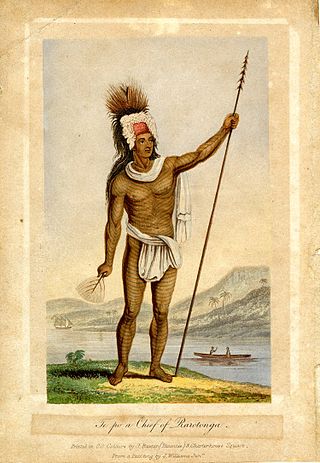Related Research Articles

The Cook Islands is a self-governing island country in the South Pacific Ocean in free association with New Zealand. It comprises 15 islands whose total land area is 240 square kilometres (93 sq mi). The Cook Islands' Exclusive Economic Zone (EEZ) covers 1,960,027 square kilometres (756,771 sq mi) of ocean.

The Cook Islands are named after Captain James Cook, who visited the islands in 1773 and 1777, although Spanish navigator Alvaro de Mendaña was the first European to reach the islands in 1595. The Cook Islands became aligned to the United Kingdom in 1890, largely because of the fear of British residents that France might occupy the islands as it already had Tahiti.

Like most countries and territories in Oceania, telecommunications in the Cook Islands is limited by its isolation and low population, with only one major television broadcasting station and six radio stations. However, most residents have a main line or mobile phone. Its telecommunications are mainly provided by Telecom Cook Islands, who is currently working with O3b Networks, Ltd. for faster Internet connection.
This article lists transport in the Cook Islands.

Aitutaki, also traditionally known as Araʻura and Utataki, is the second most-populated island in the Cook Islands, after Rarotonga. It is an "almost atoll", with fifteen islets in a lagoon adjacent to the main island. Total land area is 18.05 km2 (6.97 sq mi), and the lagoon has an area of between 50 and 74 km2. A major tourist destination, Aitutaki is the second most visited island of the Cook Islands.

Pukapuka, formerly Danger Island, is a coral atoll in the northern group of the Cook Islands in the Pacific Ocean. It is one of the most remote islands of the Cook Islands, situated about 1,140 kilometres northwest of Rarotonga. On this small island, an ancient culture and distinct language has been maintained over many centuries. The traditional name for the atoll is Te Ulu-o-Te-Watu, and the northern islet where the people normally reside is affectionately known as Wale ('Home').

Atiu, also known as Enuamanu, is an island of the Cook Islands archipelago, lying in the central-southern Pacific Ocean. Part of the Nga-pu-Toru, it is 214 km (133 mi) northeast of Rarotonga. The island's population has dropped by two-thirds in the last 50 years.
Cook Islands Māori is an Eastern Polynesian language that is the official language of the Cook Islands. Cook Islands Māori is closely related to New Zealand Māori, but is a distinct language in its own right. Cook Islands Māori is simply called Māori when there is no need to disambiguate it from New Zealand Māori, but it is also known as Māori Kūki ʻĀirani or controversially Rarotongan. Many Cook Islanders also call it Te reo Ipukarea, literally "the language of the Ancestral Homeland".

Cyclone Percy was the seventh named storm of the 2004–05 South Pacific cyclone season and the fourth and final severe tropical cyclone to form during the 2004–05 South Pacific cyclone season. Cyclone Percy originated as a tropical disturbance on February 23. Over the course of the next few days, the system organized while moving east-southeastward, before intensifying into a Category 1 tropical cyclone on the Australian region scale on February 26. The system quickly intensified, reaching Category 4 status later that day. On the next day, Percy was steered southward by a blocking ridge of high pressure, while stretched out the structure of the storm into an elliptical shape, weakening it back to Category 3 status. Afterward, the storm rapidly reintensified, reaching its peak intensity as a Category 5 tropical cyclone on March 2. Afterward, Percy encountered increasing wind shear and weakened once again, turning southeastward on the next day. On March 5, Percy transitioned into an extratropical storm, before dissipating soon afterward.

Cook Islands Cricket Association is the official governing body of the sport of cricket in Cook Islands. Its current headquarters is in Rarotonga, Cook Islands. Cook Islands Cricket Association is Cook Islands's representative at the International Cricket Council and is an affiliate member and has been a member of that body since 2000. It is also a member of the East Asia-Pacific Cricket Council. Cricket in the Cook Islands has been around for over a hundred years. The first official record of cricket is in 1910 with the registration of the Rarotonga Cricket Association, however photos pre date this to at least the late 19th century. In 2012 CICA was struck of the register. The CICA organises the Cook Islands men's and women's national teams. In 2017, became an associate member
Te Ariki Terau Mana Strickland BEM was a Cook Island educator and politician. He was the Minister of Education in the first Cook Islands government after self-government was obtained in 1965.

Mark Stephen Brown is a Cook Islands politician and Prime Minister of the Cook Islands. He had previously served as Deputy Prime Minister under Henry Puna. He is a member of the Cook Islands Party.

As of 2010, dengue fever is believed to infect 50 to 100 million people worldwide a year with 1/2 million life-threatening infections. It dramatically increased in frequency between 1960 and 2010, by 30 fold. This increase is believed to be due to a combination of urbanization, population growth, increased international travel, and global warming. The geographical distribution is around the equator with 70% of the total 2.5 billion people living in endemic areas from Asia and the Pacific. Many of the infected people during outbreaks are not virally tested, therefore their infections may also be due to chikungunya, a coinfection of both, or even other similar viruses.

Severe Tropical Cyclone Pat was a small but strong tropical cyclone that passed directly over Aitutaki, Cook Islands, in southern Pacific Ocean on February 10, 2010. Part of a series of storms to impact the group of islands early that year, Pat was first identified as a tropical depression on February 6 well to the northeast of the Samoan Islands. The storm steadily organized as it moved generally southeast, becoming a tropical cyclone on February 8. Turning to the south, intensification began in earnest and the system acquired hurricane-force winds within 48 hours of being named. The 445 km (275 mi) wide system displayed annular characteristics and a 19 km (12 mi) wide eye. Pat reached its peak strength early on February 10 as a severe tropical cyclone with winds of 140 km/h (85 mph) and a barometric pressure of 960 mbar. Hours later it struck Aitutaki, producing gusts in excess of 185 km/h (115 mph) on the island. Hostile wind shear then prompted rapid weakening of the cyclone. The system degraded below gale-intensity on February 11, just 24 hours after it peaked, and was last noted early on February 12.
In October 2013, there was an outbreak of Zika fever in French Polynesia, the first outbreak of several Zika outbreaks across Oceania. With 8,723 cases reported, it was the largest outbreak of Zika fever before the outbreak in the Americas that began in April 2015. An earlier outbreak occurred on Yap Island in the Federated States of Micronesia in 2007, but it is thought that the 2013–2014 outbreak involved an independent introduction of the Zika virus from Southeast Asia. Investigators suggested that the outbreaks of mosquito-borne diseases in the Pacific from 2012 to 2014 were "the early stages of a wave that will continue for several years", particularly because of their vulnerability to infectious diseases stemming from isolation and immunologically naive populations.

The 2019–2020 dengue fever epidemic was an epidemic of the infectious disease dengue fever in several countries of Southeast Asia, including the Philippines, Malaysia, Vietnam, and Bangladesh, Pakistan, India, Thailand, Singapore, and Laos. The spread of the disease was exacerbated by falling vaccination levels in certain areas, and by a growing population of mosquitoes, which are the primary carriers of the disease, and which are able to reproduce in larger numbers where humans have littered the environment with plastic containers, which provide an ideal breeding ground for mosquitoes. Affected countries have sought to control the epidemic through increased vaccination efforts, and through efforts to control the mosquito population.

The COVID-19 pandemic in the Cook Islands is part of the ongoing worldwide pandemic of coronavirus disease 2019 caused by severe acute respiratory syndrome coronavirus 2. As of 30 October 2021, 12,841 first doses and 12,498 second doses of vaccine had been administered, which represents over 97% of the eligible population (12+) fully vaccinated.
Tingika Elikana is a Cook Islands civil servant and politician and member of the Cook Islands Parliament. He is a member of the Cook Islands Party.

Severe Tropical Cyclone Peni was the first and only tropical cyclone to impact and cause significant damage to the Cook Islands in the 1990 South Pacific cyclone season. A shallow area of low-pressure began to develop near Rakahanga, an island in the Cook Island chain. The storm had also formed on the South Pacific convergence zone. The storm was first recognized on February 12, and had received tropical cyclone characteristics on the 13th. At 21:00 UTC, the storm was recognized as Tropical Cyclone Peni. The storm then took a path southwest towards the Cook Islands, Peni made a narrow turn and passed close to Aitutaki. Peni had gained hurricane status on the 15th, at 06:00 UTC. Peni had been able to keep hurricane characteristics until February 17, when it was downgraded to a storm, and soon, was declared extratropical. The name Peni was retired from the naming list.
In the 2020 dengue outbreak in Singapore, a record-breaking number of dengue fever cases was reported in Singapore. This was part of the wider 2019–2020 dengue fever epidemic which also affected several neighbouring countries in Southeast Asia.
References
- ↑ "Dengue update 27 February 2019 - Cook Islands". ReliefWeb. Retrieved 20 May 2019.
- ↑ "Cook Islands declare dengue outbreak in Rarotonga, 1st in a decade". Outbreak News Today. 28 February 2019. Retrieved 23 May 2019.
- ↑ "Dengue-1 Outbreak in the Cook Islands: Situation Report 10: ending 12 March 2020 - Reporting Date: 13 March 2020". ReliefWeb. 14 March 2020. Retrieved 13 November 2020.
- ↑ Losirene Lacanivalu (6 August 2020). "Health officials confirm spread of dengue in Pa Enua". Cook Islands News. Retrieved 13 November 2020.
- ↑ Losirene Lacanivalu (31 October 2020). "Dengue in Pa Enua controlled". Cook Islands News. Retrieved 13 November 2020.
- 1 2 Losirene Lacanivalu (7 November 2020). "Dengue fever defeated". Cook Islands News. Retrieved 13 November 2020.